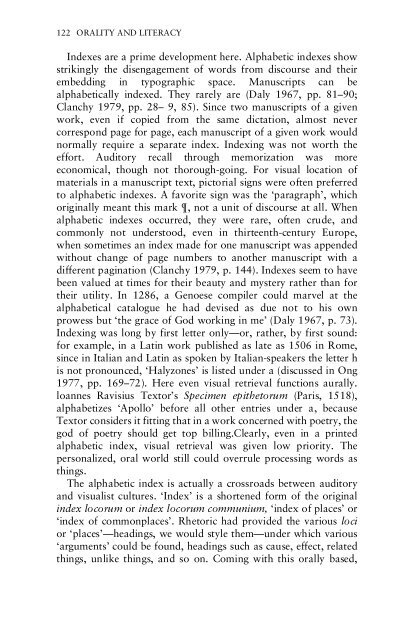Orality and Literacy: The Technologizing of the Word - Monoskop
Orality and Literacy: The Technologizing of the Word - Monoskop
Orality and Literacy: The Technologizing of the Word - Monoskop
You also want an ePaper? Increase the reach of your titles
YUMPU automatically turns print PDFs into web optimized ePapers that Google loves.
122 ORALITY AND LITERACY<br />
Indexes are a prime development here. Alphabetic indexes show<br />
strikingly <strong>the</strong> disengagement <strong>of</strong> words from discourse <strong>and</strong> <strong>the</strong>ir<br />
embedding in typographic space. Manuscripts can be<br />
alphabetically indexed. <strong>The</strong>y rarely are (Daly 1967, pp. 81–90;<br />
Clanchy 1979, pp. 28– 9, 85). Since two manuscripts <strong>of</strong> a given<br />
work, even if copied from <strong>the</strong> same dictation, almost never<br />
correspond page for page, each manuscript <strong>of</strong> a given work would<br />
normally require a separate index. Indexing was not worth <strong>the</strong><br />
effort. Auditory recall through memorization was more<br />
economical, though not thorough-going. For visual location <strong>of</strong><br />
materials in a manuscript text, pictorial signs were <strong>of</strong>ten preferred<br />
to alphabetic indexes. A favorite sign was <strong>the</strong> ‘paragraph’, which<br />
originally meant this mark , not a unit <strong>of</strong> discourse at all. When<br />
alphabetic indexes occurred, <strong>the</strong>y were rare, <strong>of</strong>ten crude, <strong>and</strong><br />
commonly not understood, even in thirteenth-century Europe,<br />
when sometimes an index made for one manuscript was appended<br />
without change <strong>of</strong> page numbers to ano<strong>the</strong>r manuscript with a<br />
different pagination (Clanchy 1979, p. 144). Indexes seem to have<br />
been valued at times for <strong>the</strong>ir beauty <strong>and</strong> mystery ra<strong>the</strong>r than for<br />
<strong>the</strong>ir utility. In 1286, a Genoese compiler could marvel at <strong>the</strong><br />
alphabetical catalogue he had devised as due not to his own<br />
prowess but ‘<strong>the</strong> grace <strong>of</strong> God working in me’ (Daly 1967, p. 73).<br />
Indexing was long by first letter only—or, ra<strong>the</strong>r, by first sound:<br />
for example, in a Latin work published as late as 1506 in Rome,<br />
since in Italian <strong>and</strong> Latin as spoken by Italian-speakers <strong>the</strong> letter h<br />
is not pronounced, ‘Halyzones’ is listed under a (discussed in Ong<br />
1977, pp. 169–72). Here even visual retrieval functions aurally.<br />
loannes Ravisius Textor’s Specimen epi<strong>the</strong>torum (Paris, 1518),<br />
alphabetizes ‘Apollo’ before all o<strong>the</strong>r entries under a, because<br />
Textor considers it fitting that in a work concerned with poetry, <strong>the</strong><br />
god <strong>of</strong> poetry should get top billing.Clearly, even in a printed<br />
alphabetic index, visual retrieval was given low priority. <strong>The</strong><br />
personalized, oral world still could overrule processing words as<br />
things.<br />
<strong>The</strong> alphabetic index is actually a crossroads between auditory<br />
<strong>and</strong> visualist cultures. ‘Index’ is a shortened form <strong>of</strong> <strong>the</strong> original<br />
index locorum or index locorum communium, ‘index <strong>of</strong> places’ or<br />
‘index <strong>of</strong> commonplaces’. Rhetoric had provided <strong>the</strong> various loci<br />
or ‘places’—headings, we would style <strong>the</strong>m—under which various<br />
‘arguments’ could be found, headings such as cause, effect, related<br />
things, unlike things, <strong>and</strong> so on. Coming with this orally based,

















